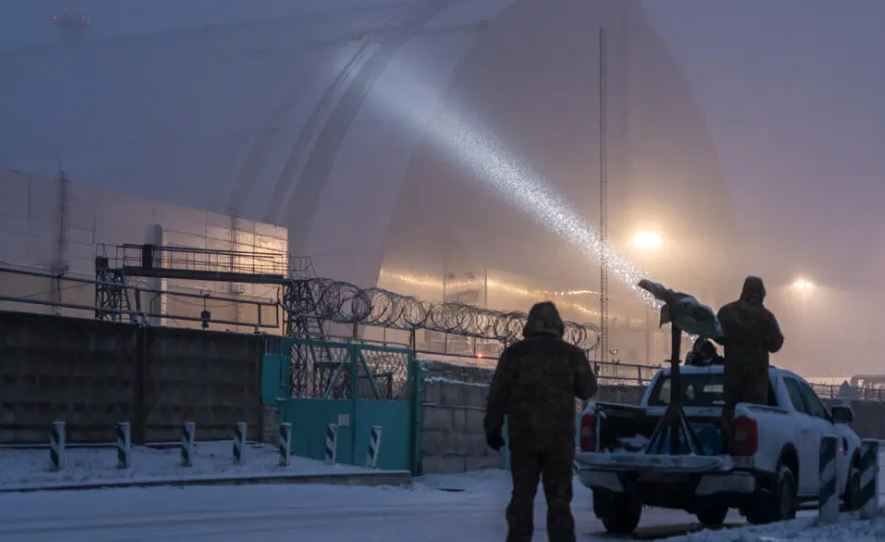Discover the resilience of workers battling ice, fire, and nuclear hazards above Chernobyl, showcasing their courage in the face of daunting challenges.
Introduction Above Chernobyl
The Chernobyl Exclusion Zone, a vast expanse of abandoned settlements and contaminated landscapes, stands as a chilling monument to humanity’s potential for both scientific advancement and catastrophic failure. Thirty-eight years after the devastating explosion that ripped through Reactor No. 4, the site continues to demand vigilance and extraordinary engineering feats. And high above the scarred reactor, dwarfed by the colossal New Safe Confinement (NSC) arch, a dedicated team of workers confronts a unique and perilous challenge: battling ice, fire, and the persistent threat of nuclear contamination.
The NSC, a marvel of modern engineering, is an enormous arch-shaped structure designed to contain the radioactive wreckage of Reactor No. 4 and prevent further release of harmful materials. Its primary purpose is containment, encapsulating the destroyed reactor within a controlled environment. But the immense size and complex structure of the NSC present their own unique set of challenges, particularly in the unpredictable and often harsh Ukrainian climate.
The Iceman Cometh: Battling Winter’s Grip
Winter in Chernobyl can be brutal. Temperatures plummet well below freezing, and heavy snowfall blankets the entire exclusion zone. The sheer scale of the NSC, spanning 257 meters wide and 108 meters high, means that vast surfaces are exposed to these extreme conditions. As snow melts and refreezes, ice forms in critical areas, posing a significant threat to the structure’s integrity.
The ice accretion on the NSC isn’t just a cosmetic issue; it’s a serious safety concern. Excessive ice buildup can add significant weight to the structure, potentially exceeding design limitations and stressing load-bearing elements. Furthermore, falling ice can damage the NSC’s outer layers, compromising its protective barrier. Ice formations can also clog drainage systems, leading to water accumulation and further exacerbating the problem.https://www.giggle.ink/news/
“The weight of the ice can be enormous, especially after a heavy snowfall followed by a freeze-thaw cycle,” explains Sergei, a senior engineer responsible for NSC maintenance. “We have a dedicated team constantly monitoring ice formation and working to prevent its build-up. It’s a race against time, especially during the harshest months.”
The team employs a variety of methods to combat ice. These include:
- Thermal Imaging and Monitoring: Using sophisticated thermal cameras, engineers identify areas prone to ice formation and assess the extent of the buildup. This allows them to target their efforts effectively.
- Mechanical Removal: Workers, equipped with specialized safety gear and harnesses, manually chip away at ice formations using hand tools and pneumatic hammers. This is a slow and arduous process, demanding precision and extreme caution.
- Heating Systems: Strategically placed heating cables and radiant panels are used to melt ice in critical areas, such as drainage channels and load-bearing joints. These systems require constant monitoring to ensure they operate efficiently and don’t create new problems.
- Anti-Icing Compounds: In some cases, environmentally friendly anti-icing compounds are applied to surfaces to prevent ice formation. However, the use of these compounds is carefully controlled to minimize any potential impact on the environment and the NSC’s materials.
The fight against ice is a constant, relentless battle. The team works around the clock throughout the winter months, ensuring the NSC’s integrity and protecting the surrounding environment.
Playing with Fire: Preventing Catastrophe Reborn
While the immediate threat of a nuclear explosion has long passed, the legacy of Chernobyl continues to burn – literally. Within the ruins of Reactor No. 4 lies a complex mixture of radioactive materials, including uranium, plutonium, and graphite. This intensely radioactive “fuel-containing material” (FCM), often referred to as lava or Elephant’s Foot, is prone to spontaneous heating due to the ongoing decay of radioactive elements.
This inherent heat, combined with the presence of combustible materials within the reactor’s remains and the potential for electrical malfunctions, creates a significant fire hazard. A fire within the NSC could release radioactive particles into the atmosphere, posing a threat to workers, the surrounding environment, and potentially even beyond.https://www.newsx.com/world/justice-department-moves-to-drop-corruption-charges-against-nyc-mayor-eric-adams/
“Fire is one of our biggest concerns,” acknowledges Irina, the head of the fire safety team at Chernobyl. “The consequences of a fire within the NSC could be devastating. We have to be constantly vigilant and prepared for any eventuality.”
The fire safety team employs a multi-layered approach to prevent and mitigate the risk of fire:
- Advanced Fire Detection Systems: A sophisticated network of smoke detectors, heat sensors, and flame detectors is installed throughout the NSC, providing early warning of any potential fire. These systems are constantly monitored by a dedicated control room.
- Fire Suppression Systems: A comprehensive array of fire suppression systems is in place, including water sprinklers, foam suppression systems, and inert gas systems. These systems are designed to quickly extinguish any fire, minimizing the release of radioactive materials.
- Fireproofing Materials: Wherever possible, fire-resistant materials have been used in the construction and maintenance of the NSC, reducing the risk of fire spread.
- Regular Inspections and Maintenance: The fire safety team conducts regular inspections of all fire detection and suppression systems, ensuring they are in optimal working condition. They also perform routine maintenance to prevent electrical malfunctions and other potential fire hazards.
- Emergency Response Training: All workers at Chernobyl undergo extensive emergency response training, including fire drills and evacuation procedures. This ensures that everyone knows how to respond quickly and effectively in the event of a fire.
The fire safety team works in close collaboration with other departments, including the radiation monitoring team and the engineering team, to ensure a coordinated response to any potential fire. Their vigilance and dedication are essential to preventing a repeat of the Chernobyl disaster.
Living Under the Shadow: Nuclear Fears and Safety Protocols
While the NSC provides a significant improvement in containing radioactive materials, the threat of radiation exposure remains a constant reality for workers at Chernobyl. The FCM within Reactor No. 4 continues to emit radiation, and the surrounding environment is still contaminated with radioactive particles.
Working within the Exclusion Zone requires strict adherence to safety protocols and a deep understanding of the risks involved. Workers are equipped with personal protective equipment (PPE), including respirators, protective suits, and radiation dosimeters. They undergo regular medical checkups and radiation monitoring to ensure their safety.
“We are always aware of the radiation,” says Dimitri, a radiation safety specialist. “It’s a part of our everyday lives here. We follow strict protocols to minimize our exposure and protect ourselves and our colleagues.”
The key safety protocols include:
- Time Limits: Workers are limited to the amount of time they can spend in high-radiation areas. These time limits are carefully calculated to ensure that their radiation exposure remains within safe levels.
- Zoning and Access Control: The Chernobyl site is divided into different zones, each with varying levels of radiation. Access to these zones is strictly controlled, and workers are only allowed to enter areas they are authorized to be in.
- Decontamination Procedures: Before leaving contaminated areas, workers undergo thorough decontamination procedures to remove any radioactive particles from their clothing and equipment.
- Continuous Radiation Monitoring: Radiation levels are continuously monitored throughout the site, both inside and outside the NSC. This data is used to identify areas of high radiation and to adjust safety protocols as needed.
- Psychological Support: Working in the Chernobyl Exclusion Zone can be psychologically challenging. Workers are provided with access to psychological support services to help them cope with the stress and anxiety associated with the job.
The dedication and professionalism of the Chernobyl workers are truly remarkable. They understand the risks involved and are committed to working safely and responsibly. Their efforts are essential to ensuring the long-term safety and security of the Chernobyl site and the surrounding environment.
A Legacy of Learning and a Future of Hope
The workers high above Chernobyl are not just battling ice, fire, and nuclear fears. They are also contributing to a legacy of learning and a future of hope. The lessons learned from the Chernobyl disaster have had a profound impact on nuclear safety standards worldwide. The design and construction of the NSC represent a significant advancement in containment technology.
The ongoing work at Chernobyl is not just about cleaning up the past; it’s also about building a safer future. The knowledge and experience gained at Chernobyl are being shared with the international community, helping to prevent future nuclear accidents and to improve the safety of nuclear facilities around the world.
The men and women who work at Chernobyl are true heroes. They face extraordinary challenges with courage, dedication, and professionalism. Their work is a testament to the resilience of the human spirit and our ability to overcome even the most daunting challenges. As they grapple with ice, fire, and nuclear fears high above the ruined reactor, they are also building a legacy of safety, security, and hope for future generations. The shadow of Chernobyl may loom large, but the light of their work shines even brighter.


